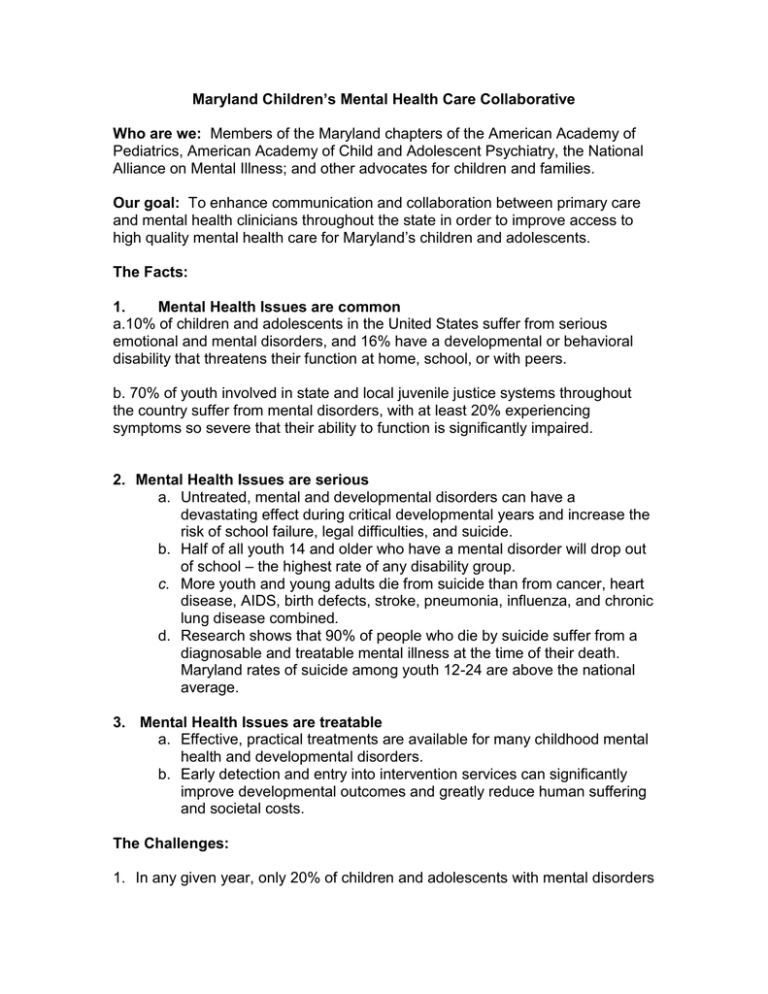MCMC goals statement
advertisement

Maryland Children’s Mental Health Care Collaborative Who are we: Members of the Maryland chapters of the American Academy of Pediatrics, American Academy of Child and Adolescent Psychiatry, the National Alliance on Mental Illness; and other advocates for children and families. Our goal: To enhance communication and collaboration between primary care and mental health clinicians throughout the state in order to improve access to high quality mental health care for Maryland’s children and adolescents. The Facts: 1. Mental Health Issues are common a.10% of children and adolescents in the United States suffer from serious emotional and mental disorders, and 16% have a developmental or behavioral disability that threatens their function at home, school, or with peers. b. 70% of youth involved in state and local juvenile justice systems throughout the country suffer from mental disorders, with at least 20% experiencing symptoms so severe that their ability to function is significantly impaired. 2. Mental Health Issues are serious a. Untreated, mental and developmental disorders can have a devastating effect during critical developmental years and increase the risk of school failure, legal difficulties, and suicide. b. Half of all youth 14 and older who have a mental disorder will drop out of school – the highest rate of any disability group. c. More youth and young adults die from suicide than from cancer, heart disease, AIDS, birth defects, stroke, pneumonia, influenza, and chronic lung disease combined. d. Research shows that 90% of people who die by suicide suffer from a diagnosable and treatable mental illness at the time of their death. Maryland rates of suicide among youth 12-24 are above the national average. 3. Mental Health Issues are treatable a. Effective, practical treatments are available for many childhood mental health and developmental disorders. b. Early detection and entry into intervention services can significantly improve developmental outcomes and greatly reduce human suffering and societal costs. The Challenges: 1. In any given year, only 20% of children and adolescents with mental disorders are identified and receive mental health services. 2. For many children the delay from onset of symptoms to first treatment is measured not in weeks or months but in years. 3. The US has only 20% of the child psychiatrists thought to be needed; even with current efforts to increase the number trained, it is thought that this deficit will persist for the foreseeable future. 4. The problem is especially great in rural areas: in Maryland, youth suicide rates in rural counties are substantially higher than in urban areas, but mental health care is much more difficult to obtain. Maryland has about 230 child psychiatrists in active clinical practice – more than many states – but nearly all are located in major metropolitan areas. The Potential: 1. Pediatric primary care providers (doctors, nurse practitioners, and physician’s assistants) are “natural partners” in mental health care. a. They already have an established therapeutic relationship with the child and family. b. The services they provide through this “medical home” model are often seen as less stigmatized than attending a mental health office or clinic. 2. Pediatric primary care providers are trained in providing comprehensive medical care to children and adolescents. a. Much of their interaction with patients is prevention-oriented and involves screening for developmental, behavioral, and emotional disorders. 3. The mental health service capacity of primary care is underestimated and underutilized. a. Pediatric primary care providers differ in their knowledge base and comfort level in treating and managing mental health disorders, but many are willing and open to learning more mental health skills and strategies. 4. Opportunity to create relationships a. A barrier to utilizing the mental health potential of primary care is lack of collaborative relationships between primary care and mental health professionals. b. A collaborative approach could provide the critical sharing of skills and expertise between primary care and mental health providers necessary to transform and optimize the delivery of mental health care to Maryland’s children ,adolescents, and families. Our aims: 1. Support Maryland primary care providers who offer mental health services by: a. Facilitating timely consultations from psychiatrists and other mental health professionals to assist in evaluating new patients or caring for established ones. b. Providing opportunities for mental health training and tools for screening, prevention, treatment and monitoring for primary care providers. c. Improving reimbursement for mental health services delivered in primary care settings and for mental health specialists’ consultations to primary care. 2. Increase the proportion of primary care practices in Maryland with a “colocated” mental health professional. 3. Improve mechanisms that allow for high-quality, coordinated care shared between a primary care provider and a mental health specialist 4. Help develop a “Collaboration Report Card” to track our progress on meeting these goals and identifying areas of the state in need of action. How you can be involved? 1. Be on one of our program committees – consultation, education, or colocation. 2. Send us your thoughts and suggestions. 3. Make a presentation to our executive committee. 4. Sign on as a supporter, individually or as an organization. Contact us: www.mmhi.blogspot.com





